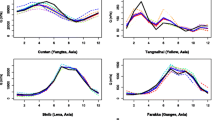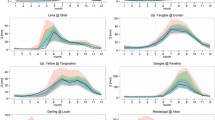Abstract
Ideally, the results from models operating at different scales should agree in trend direction and magnitude of impacts under climate change. However, this implies that the sensitivity to climate variability and climate change is comparable for impact models designed for either scale. In this study, we compare hydrological changes simulated by 9 global and 9 regional hydrological models (HM) for 11 large river basins in all continents under reference and scenario conditions. The foci are on model validation runs, sensitivity of annual discharge to climate variability in the reference period, and sensitivity of the long-term average monthly seasonal dynamics to climate change. One major result is that the global models, mostly not calibrated against observations, often show a considerable bias in mean monthly discharge, whereas regional models show a better reproduction of reference conditions. However, the sensitivity of the two HM ensembles to climate variability is in general similar. The simulated climate change impacts in terms of long-term average monthly dynamics evaluated for HM ensemble medians and spreads show that the medians are to a certain extent comparable in some cases, but have distinct differences in other cases, and the spreads related to global models are mostly notably larger. Summarizing, this implies that global HMs are useful tools when looking at large-scale impacts of climate change and variability. Whenever impacts for a specific river basin or region are of interest, e.g. for complex water management applications, the regional-scale models calibrated and validated against observed discharge should be used.




Similar content being viewed by others
References
Abbaspour KC, Yang J, Maximov I, Siber R, Bogner K, Mieleitner J, Zobrist J, Srinivasan R (2007) Modelling of hydrology and water quality in the pre-alpine/alpine Thur watershed using SWAT. J Hydrol 333:413–430
Bosshard T, Carambia M, Goergen K, Kotlarski S, Krahe P, Zappa M, Schaer C (2013) Quantifying uncertainty sources in an ensemble of hydrological climate-impact projections. Water Resour Res 49:1523–1536
Breuer L, Huisman JA, Willems P, Bormann H, Bronstert A, Croke BFW, Frede HG, Graeff T, Hubrechts L, Jakeman AJ, Kite G, Lanini J, Leavesley G, Lettenmaier DP, Lindstroem G, Seibert J, Sivapalan M, Viney NR (2009) Assessing the impact of land use change on hydrology by ensemble modeling (LUCHEM). I: Model intercomparison with current land use. Adv Water Resour 32:129–146
Chen X, Yang T, Wang X, Xu C-Y, Yu Z (2013) Uncertainty intercomparison of different hydrological models in simulating extreme flows. Water Resour Manag 27(5):1393–1409
Dankers R, Arneli NW, Clark DB, Falloon PD, Fekete BM, Gosling SN, Heinke J, Kim H, Masaki Y, Satoh Y, Stacke T, Wada Y, Wisser D (2014) First look at changes in flood hazard in the inter-sectoral impact model intercomparison project ensemble. PNAS 111(9):3257–3261
Davie JCS et al (2013) Comparing projections of future changes in runoff from hydrological and biome models in ISI-MIP. Earth Syst Dynam. doi:10.5194/esdd-4-279-2013
Donnelly C, Andersson J, Arheimer B (2015) Using flow signatures and catchment similarities to evaluate the E-HYPE multi-basin model across Europe. Hydrol Sci J. doi:10.1080/02626667.2015.1027710
Eisner S (2016) Comprehensive evaluation of the WaterGAP3 model across climatic, physiographic, and anthropogenic gradients. PhD thesis. University of Kassel, Kassel, Germany. Available at http://nbn-resolving.de/urn:nbn:de:hebis:34-2016031450014
Feyen L, Dankers R, Bódis K, Salamon P, Barredo JI (2012) Fluvial flood risk in Europe in present and future climates. Clim Chang 112(1):47–62. doi:10.1007/s10584-011-0339-7
Gosling SN, Arnell NW (2011) Simulating current global river runoff with a global hydrological model: model revisions, validation, and sensitivity analysis. Hydrol Process 25(7):1099–1085. doi:10.1002/hyp.7727
Gosling SN, Taylor RG, Arnell NW, Todd MC (2011) A comparative analysis of projected impacts of climate change on river runoff from global and catchment-scale hydrological models. Hydrol Earth Syst Sci 15:279–294. doi:10.5194/hess-15-279-2011
Gosling SN, Zaherpour J, Mount NJ, Hattermann F, Dankers R, Arheimer B, Breuer L, Ding Haddeland, I, Kumar R, Kundu D, Liu J, van Griensven A, Veldkamp T, Vetter T, Wang X, Zhang X (2016) A comparison of changes in river runoff from multiple global and catchment-scale hydrological models under global warming scenarios of 1°C, 2°C and 3°C. Clim Chang. doi:10.1007/s10584-016-1773-3
GRDC, BfG The GRDC - Global Runoff Database. Available at: http://www.bafg.de/nn_266934/GRDC/EN/01__GRDC/03__Database/database__node.html?__nnn=true. Accessed 7 Feb 2013
Haddeland I, Heinke J, Biemans H, Eisner S, Flörke M, Hanasaki N, Konzmann M, Ludwig F, Masaki Y, Schewe J, Stacke T, Tessler ZD, Wada Y, Wisser D (2014) Global water resources affected by human interventions and climate change. PNAS 111(9):3251–3256. doi:10.1073/pnas.1222475110
Hagemann S, Chen C, Clark DB, Folwell S, Gosling SN, Haddeland I, Hanasaki N, Heinke J, Ludwig F, Voss F, Wiltshire AJ (2013) Climate change impact on available water resources obtained using multiple global climate and hydrology models. Earth Syst Dynam 4:129–144. doi:10.5194/esd-4-129-2013
Hattermann FF, Wattenbach M, Krysanova V, Wechsung F (2005) Runoff simulations on the macroscale with the ecohydrological model SWIM in the Elbe catchment—validation and uncertainty analysis. Hydrol Process 19(3):693–714
Hattermann FF, Krysanova V, Habeck A, Bronstert A (2006) Integrating wetlands and riparian zones in river basin modelling. Ecol Model 199:379–392
Hattermann FF, Weiland M, Huang S, Krysanova V, Kundzewicz ZW (2011) Model-supported impact assessment for the water sector in central Germany under climate change—a case study. Water Resour Manag 25(13):3113–3134
Hattermann FF, Huang S, Burghoff O, Willems W, Österle H, Büchner M, Kundzewicz ZW (2014) Modelling flood damages under climate change conditions—a case study for Germany. Nat Hazards Earth Syst Sci 14(12):3151–3168, http://www.nat-hazards-earth-syst-sci.net/14/3151/2014/nhess-14-3151-2014.html
Hempel S, Frieler K, Warszawski L, Schewe J, Piontek F (2013) A trend-preserving bias correction—the ISI-MIP approach. Earth Syst Dyn Discuss 4:49–92. doi:10.5194/esdd-4-49
Huang S, et al (2016) Evaluation of an ensemble of regional hydrological models with respect to simulation of seasonal dynamics, floods and droughts in 12 large river basins. Clim Chang. doi:10.1007/s10584-016-1841-8
IPCC (2013) Climate change 2013: the physical science basis—summary for policymakers. Contribution of Working Group I to the Fifth Assessment Report of the Intergovernmental Panel on Climate Change. – Intergovernmental Panel on Climate Change. IPCC Secretariat
Kingsford RT (2000) Ecological impacts of dams, water diversions and river management on floodplain wetlands in Australia. Austral Ecology 25:109–127. doi:10.1046/j.1442-9993.2000.01036.x
Koch H, Liersch S, Hattermann FF (2013) Integrating water resources management in eco-hydrological modelling. Water Sci Technol 67(7):1525–1533
Krysanova V, Hattermann FF, Wechsung F (2005) Development of the ecohydrological model SWIM for regional impact studies and vulnerability assessment. Hydrol Process 19:763–783
Merz R, Parajka J, Blöschl G (2011) Time stability of catchment model parameters – implications for climate impact analyses. Water Resour Res 47(2). doi:10.1029/2010WR009505
Müller-Schmied H, Eisner S, Franz D, Wattenbach M, Portmann FT, Flörke M, Döll P (2014) Sensitivity of simulated global-scale freshwater fluxes and storages to input data, hydrological model structure, human water use and calibration. Hydrol Earth Syst Sci 18:3511–3538
Piniewski M, Laizé CLR, Acreman MC, Okruszko T, Schneider C (2014) Effect of climate change on environmental flow indicators in the Narew Basin, Poland. J Environ Qual 43(1):155–167. doi:10.2134/jeq2011.0386
Portmann FT, Döll P, Eisner S, Flörke M (2013) Impact of climate change on renewable groundwater resources: assessing the benefits of avoided greenhouse gas emissions using selected CMIP5 climate projections. Environ Res Lett 8(2):024023
Prudhomme C, Giuntoli I, Robinson EL, Clark DB, Arneli NW, Dankers R, Fekete BM, Franssen W, Gerten D, Gosling SN, Hagemann S, Hannah DM, Kim H, Masaki Y, Satoh Y, Stacke T (2014) Hydrological droughts in the 21st century: hotspots and uncertainties from a global multi-model ensemble experiment. PNAS 111(9):3262–3267
Rakovec O, Kumar R, Mai J, Cuntz M, Thober S, Zink M, Attinger S, Schäfer D, Schrön M, Samaniego L (2016a) Multiscale and multivariate evaluation of water fluxes and states over European river basins J. Hydrometeorol. 17(1):287–307
Rakovec O, Kumar R, Attinger S, Samaniego L, (2016b) Improving the realism of hydrologic model functioning through multivariate parameter estimation Water Resour. Res. 52 (10):7779–7792
Schellnhuber HJ, Frieler K, Kabat P (2014) The elephant, the blind, and the ISI-MIP. PNAS 111(9):3225–3227
Schewe J, et al (2014) Multi-model assessment of water scarcity under climate change. PNAS 111(2014). doi:10.1073/pnas.1222460110
Strauch M, Kumar R, Eisner S, Mulligan M, Reinhardt J, Santini W, Vetter T, Friesen J (2016) Adjustment of global precipitation data for enhanced hydrologic modeling of tropical Andean watersheds. Clim Chang (Online first): doi:10.1007/s10584-016-1706-1
Tang Q, Oki T, Kanae S, Hu H (2007) The influence of precipitation variability and partial irrigation within grid cells on a hydrological simulation. J Hydrometeorol 8:499–512. doi:10.1175/JHM589.1
Taylor KE, Stouffer RJ, Meehl GA (2012) An overview of CMIP5 and the experiment design. Bull Am Meteorol Soc 93:485–498
Thoms MC, Sheldon F (2000) Water resource development and hydrological change in a large dryland river: the Barwon–Darling River, Australia. J Hydrol 228(1–2):10–21. doi:10.1016/S0022-1694(99)00191-2
van Vuuren D, Edmonds J, Kainuma M, Riahi K, Thomson A, Hibbard K, Hurtt G, Kram T, Krey V, Lamarque J-F, Masui T, Meinshausen M, Nakicenovic N, Smith S, Rose S (2011) The representative concentration pathways: an overview. Clim Chang 109:5–31. doi:10.1007/s10584-011-0148-z
Verzano K (2009) Climate change impacts on flood related hydrological processes: Further development and application of a global scale hydrological model, no. 71–2009 in Reports on Earth System Science, 71. Max Planck Institute for Taylor K E, Stouffer R J and Meehl G A (2012) An overview of CMIP5 and the experiment design. Bull Am Meteorol Soc 93:485–498
Vetter T, Huang S, Aich V, Yang T, Wang X, Krysanova V, Hattermann FF (2014) Multi-model climate impact assessment and intercomparison for three largescale river basins on three continents. Earth Syst Dyn Discuss 5(2):849–900
Wada Y, Wisser D, Eisner S, Flörke M, Gerten D, Haddeland I, Hanasaki N, Masaki Y, Portmann FT, Stacke T, Tessler Z, Schewe J (2013) Multi-model projections and uncertainties of irrigation water demand under climate change. Geophys Res Lett 40(17):4626–4632
Warszawski L, Frieler K, Huber V, Piontek F, Serdeczny O, Schewe J (2014) The inter-sectoral impact model intercomparison project (ISI-MIP): project framework. PNAS 111(9):3228–3232
Weedon GP, Gomes S, Viterbo P, Shuttleworth WJ, Blyth E, Osterle H, Adam JC, Bellouin N, Boucher O, Best M (2011) Creation of the watch forcing data and its use to assess global and regional reference crop evaporation over land during the twentieth century. J Hydrometeorol 12:823–848. doi:10.1175/2011JHM1369.1
Acknowledgments
This work has been conducted under the framework of ISIMIP, funded by the German Federal Ministry of Education and Research (BMBF) with project funding reference number 01LS1201A. Responsibility for the content of this publication lies with the authors. We acknowledge the World Climate Research Programme’s Working Group on Coupled Modeling, which is responsible for CMIP, and we thank the respective climate modelling groups for producing and making available their model output. We also acknowledge the support of the Global Runoff Data Centre and of the Environment Research and Technology Development Fund (S-10) of the Ministry of the Environment, Japan. This work was supported by Japan Society for the Promotion of Science KAKENHI (16H06291), and the Program for Risk Information on Climate Change supported by the Ministry of Education, Culture,Sports, Science, and Technology-Japan (MEXT).
Author information
Authors and Affiliations
Corresponding author
Additional information
This article is part of a Special Issue on “Hydrological Model Intercomparison for Climate Impact Assessment” edited by Valentina Krysanova and Fred Hattermann.
Electronic supplementary material
Below is the link to the electronic supplementary material.
ESM 1
(DOCX 18.3 mb)
Rights and permissions
About this article
Cite this article
Hattermann, F.F., Krysanova, V., Gosling, S.N. et al. Cross‐scale intercomparison of climate change impacts simulated by regional and global hydrological models in eleven large river basins. Climatic Change 141, 561–576 (2017). https://doi.org/10.1007/s10584-016-1829-4
Received:
Accepted:
Published:
Issue Date:
DOI: https://doi.org/10.1007/s10584-016-1829-4




